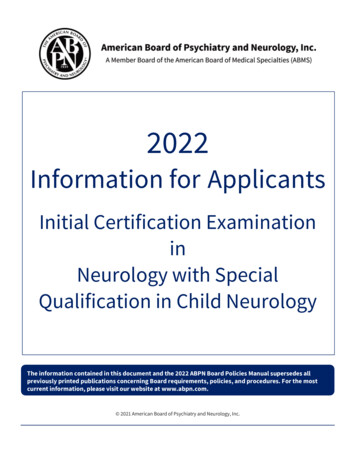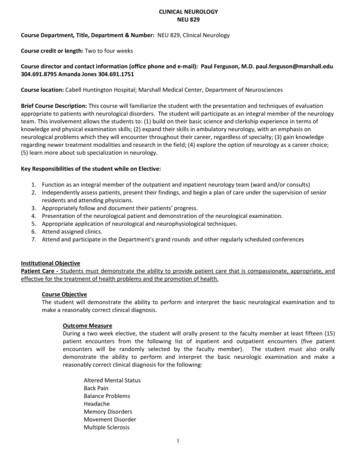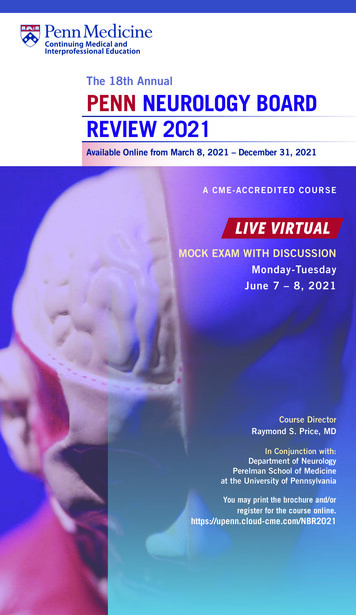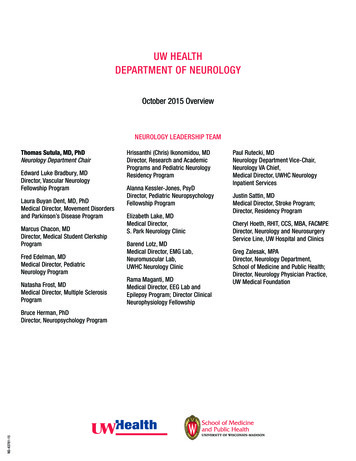
Transcription
Blueprints neurology 5th edition pdf download
You're Reading a Free Preview Pages 15 to 26 are not shown in this preview. You're Reading a Free Preview Pages 32 to 33 are not shown in this preview. You're Reading a Free Preview Pages 39 to 57 are not shown in this preview. You're Reading a Free Preview Pages 63 to 82 are not shown in this preview. You're Reading a Free Preview Pages 88to 91 are not shown in this preview. You're Reading a Free Preview Page 110 is not shown in this preview. You're Reading a Free Preview Pages 120 to 158 are not shown in this preview. You're Reading a Free Preview Pages 168 to 193 are not shown in this preview. You're Reading a Free Preview Pages 203 to 229 are not shown in this preview.You're Reading a Free Preview Pages 243 to 249 are not shown in this preview. You're Reading a Free Preview Pages 263 to 272 are not shown in this preview. You're Reading a Free Preview Pages 277 to 310 are not shown in this preview. You're Reading a Free Preview Pages 315 to 318 are not shown in this preview. You're Reading a Free PreviewPages 341 to 399 are not shown in this preview. You're Reading a Free Preview Pages 407 to 432 are not shown in this preview. You're Reading a Free Preview Pages 440 to 448 are not shown in this preview. 12887 FM.qxd 10/9/08 9:51 PM Page i BLUEPRINTS NEUROLOGY Third Edition 12887 FM.qxd 10/9/08 9:51 PM Page ii 12887 FM.qxd10/9/08 9:51 PM Page iii BLUEPRINTS NEUROLOGY Third Edition Frank W. Drislane, MD Juan Acosta, MD Associate Professor of Neurology Harvard Medical School Comprehensive Epilepsy Center Beth Israel Deaconess Medical Center Boston, Massachusetts Neurologist, Clinical Neurophysiologist European Medical Doctor Best Doctors Madrid,Spain Michael Benatar, MBChB, DPhil Andrew Tarulli, MD Associate Professor of Neurology and Epidemiology Director, Electromyography Laboratory Emory University Atlanta, Georgia Instructor in Neurology Harvard Medical School Division of Neuromuscular Disease Beth Israel Deaconess Medical Center Boston, Massachusetts Bernard S. Chang,MD Louis R. Caplan, MD Assistant Professor of Neurology Harvard Medical School Comprehensive Epilepsy Center Beth Israel Deaconess Medical Center Boston, Massachusetts Professor of Neurology Harvard Medical School Cerebrovascular Service Beth Israel Deaconess Medical Center Boston, Massachusetts 12887 FM.qxd 10/9/08 8:01 PM Pageiv Acquisitions Editor: Charley Mitchell Managing Editor: Stacey Sebring and Jessica Heise Associate Production Manager: Kevin Johnson Creative Director: Doug Smock Compositor: Maryland Composition/ASI Printer: RR Donnelly Copyright 2009 Frank W. Drislane, MD; Michael Benatar, MBChB, DPhil; and Bernard S. Chang, MD 351 WestCamden Street Baltimore, MD 21201 530 Walnut Street Philadelphia, PA 19106 All rights reserved. This book is protected by copyright. No part of this book may be reproduced in any form or by any means, including photocopying, or utilized by any information storage and retrieval system without written permission from the copyright owner. Thepublisher is not responsible (as a matter of product liability, negligence, or otherwise) for any injury resulting from any material contained herein. This publication contains information relating to general principles of medical care that should not be construed as specific instructions for individual patients. Manufacturers’ product information andpackage inserts should be reviewed for current information, including contraindications, dosages, and precautions. Printed in China Library of Congress Cataloging-in-Publication Data Blueprints neurology / Frank W. Drislane . [et al.]. — 3rd ed. p. ; cm. Includes bibliographical references and index. ISBN 978-0-7817-9685-9 1. Neurology—Examinations, questions, etc. 2. Physicians—Licenses—United States—Examinations—Study guides. I. Drislane, Frank. II. Title: Neurology. [DNLM: 1. Nervous System Diseases. 2. Neurology. WL 140 B658 2009] RC336.B575 2009 616.80076—dc22 2008025255 The publishers have made every effort to trace the copyright holders for borrowedmaterial. If they have inadvertently overlooked any, they will be pleased to make the necessary arrangements at the first opportunity. To purchase additional copies of this book, call our customer service department at (800) 638-3030 or fax orders to (301) 824-7390. International customers should call (301) 714-2324. Visit Lippincott Williams &Wilkins on the Internet: . Lippincott Williams & Wilkins customer service representatives are available from 8:30 am to 6:00 pm, EST. 12887 FM.qxd 10/9/08 9:51 PM Page v Contents Reviewers . . . . . . . . . . . . . . . . . . . . . . . . . . . . . . . . . . . . . . . . . . . . . . . . . . . . . . . . . . . . . . . . . . . . . . . . . . . .vii Preface . . . . . . . . . . . . . . . . . . . . . . . . . . . . . . . . . . . . . . . . . . . . . . . . . . . . . . . . . . . . . . . . . . . . . . . . . . . . . . . x Acknowledgments . . . . . . . . . . . . . . . . . . . . . . . . . . . . . . . . . . . . . . . . . . . . . . . . . . . . . . . . . . . . . . . . . . . . xi Abbreviations . . . . . . . . . . . . . . . . . . . . . . . . . . . . . . . . . . . . . . . . . . . . . . . . . . . . . . . . . . . . . . . . . . . . . . . . xii PART ONE: Basics of Neurology . . . . . . . . . . . . . . . . . . . . . . . . . . . . . . . . . . . . . . . . . .1 1The Neurologic Examination . . . . . . . . . . . . . . . . . . . . . . . . . . . . . . . . . . . . . . . . . . . .3 2 Neurologic Investigations . . . . . . . . . . . . . . . . . . . . . . . . . . . . . . . . . . . . . . . . . . . . . .10 PART TWO: Common Neurologic Symptoms . . . . . . . . . . . . . . . . . . . . . . . . . . . . .19 3 The Approach to Coma and Altered Consciousness . . . . . . . . . . . . . . . . . . . .21 4 NeuroOphthalmology . . . . . . . . . . . . . . . . . . . . . . . . . . . . . . . . . . . . . . . . . . . . . . . . .29 5 The Approach to Weakness . . . . . . . . . . . . . . . . . . . . . . . . . . . . . . . . . . . . . . . . . . . .40 6 The Sensory System . . . . . . . . . . . . . . . . . . . . . . . . . . . . . . . . . . . . . . . . . . . . . . . . . . . .48 7 Dizziness, Vertigo, and Syncope . . . . . . . . . . . . . . . . . . . . . . . . . . . . . . . . . . . . . . . .54 8 Ataxiaand Gait Disorders . . . . . . . . . . . . . . . . . . . . . . . . . . . . . . . . . . . . . . . . . . . . . .58 9 Urinary and Sexual Dysfunction . . . . . . . . . . . . . . . . . . . . . . . . . . . . . . . . . . . . . . . .63 10 Headache and Facial Pain . . . . . . . . . . . . . . . . . . . . . . . . . . . . . . . . . . . . . . . . . . . . . .69 PART THREE: Neurologic Disorders . . . . . . . . . . . . . . . . . . . . . . . . . . . . . . . . . . . . . 75 11Aphasia and Other Disorders of Higher Cortical Function . . . . . . . . . . . . . .77 12 Dementia . . . . . . . . . . . . . . . . . . . . . . . . . . . . . . . . . . . . . . . . . . . . . . . . . . . . . . . . . . . . . .84 13 Sleep Disorders . . . . . . . . . . . . . . . . . . . . . . . . . . . . . . . . . . . . . . . . . . . . . . . . . . . . . . . .92 14 Vascular Disease . . . . . . . . . . . . . . . . . . . . . . . . . . . . . . . . . . . . . . . . . . . . . . . . . . . . . .96 15 Seizures . . . . . . . . . . . . . . . . . . . . . . . . . . . . . . . . . . . . . . . . . . . . . . . . . . . . . . . . . . . . . . .103 16 Movement Disorders . . . . . . . . . . . . . . . . . . . . . . . . . . . . . . . . . . . . . . . . . . . . . . . . .111 17 Head Trauma . . . . . . . . . . . . . . . . . . . . . . . . . . . . . . . . . . . . . . . . . . . . . . . . . . . . . . . . .119 18 Systemic and Metabolic Disorders . . . . . . . . . . . . . . . . . . . . . . . . . . . . . . . . . . .124 19 Central Nervous System Tumors . . . . . . . . . . . . . . . . . . . . . . . . . . . . . . . . . . . . . .131 20 Demyelinating Diseases of the Central Nervous System . . . . . . . . . . . . . . .139 12887 FM.qxd 10/9/08 9:51 PM Page vi vi Contents 21 Infections of the Nervous System . . . . . . . . . . . . . . . . . . . . . . . . . . . . . . . . . . . . .145 22 Disorders of the SpinalCord . . . . . . . . . . . . . . . . . . . . . . . . . . . . . . . . . . . . . . . . . .152 23 The Peripheral Nervous System . . . . . . . . . . . . . . . . . . . . . . . . . . . . . . . . . . . . . . .159 24 Disorders of the Neuromuscular Junction and Skeletal Muscle . . . . . . . .169 25 Pediatric Neurology . . . . . . . . . . . . . . . . . . . . . . . . . . . . . . . . . . . . . . . . . . . . . . . . . . .178 Questions . . . . . . . . . . . . . . . . . . . . . . . . . . . . . . . . . . . . . . . . . . . . . . . . . . . . . . . . . . . . . . . . . . . . . . . . . .186 Answers . . . . . . . . . . . . . . . . . . . . . . . . . . . . . . . . . . . . . . . . . . . . . . . . . . . . . . . . . . . . . . . . . . . . . . . . . . . .199 Appendix: Evidence-Based Resources . . . . . . . . . . . . . . . . . . . . . . . . . . . . . . . . . . . . . . . . . . . . . . .209 Index . . . . . . . . . . . . . . . . . . . . . . . . . . . . . . . . . . . . . . . . . . . . . . . . . . . . . . . . . . . . . . . . . . . . . . . . . . . . . .212 12887 FM.qxd 10/9/08 9:51 PM Page vii Reviewers Catarina Castaneda, MD Class of 2004 Drexel University College of Medicine Philadelphia, Pennsylvania Maureen Chase, MD Resident, Emergency Medicine Hospital of University of Pennsylvania Jefferson Medical College Thomas Jefferson University HospitalPhiladelphia, Pennsylvania Suzanne Crandall Class of 2005 Kansas City University of Medicine and Biosciences Kansas City, Missouri Alexis Dang, MD Class of 2004 University of California—San Francisco San Francisco, California Lee S. Engel, MD, PhD Fellow, Department of Infectious Diseases Louisiana State University Health Sciences CenterNew Orleans, Louisiana Merritt Fajt, MD Class of 2004 Temple University School of Medicine Philadelphia, Pennsylvania R1- Internal Medicine, Penn State University Milton S. Hershey Hershey Medical Center Hershey, Pennsylvania Baback Gabbay, MD Class of 2005 David Geffen School of Medicine at UCLA Los Angeles, California 12887 FM.qxd10/9/08 9:51 PM Page viii viii Reviewers Amir A. Ghaferi Class of 2005 Johns Hopkins School of Medicine Baltimore, Maryland Hoda Ghanem, MD Intern UC Irvine—Internal Medicine Irvine, California Sarah Harper Class of 2005 University of Pittsburgh School of Medicine Pittsburgh, Pennsylvania Gloria Hsu Class of 2005 Stanford UniversitySchool of Medicine Stanford, California Mark Lassoff, MD Class of 2004 UMDNJ—New Jersey Medical School Newark, New Jersey Urology Resident LAC USC Medical Center Los Angeles, California Ryan Ley Class of 2005 University of Nevada School of Medicine Reno, Nevada Meredith M. LeQuear, DO Class of 2004 New York College ofOsteopathic Medicine Old Westbury, New York Mark Naftanel Class of 2005 Duke University School of Medicine Durham, North Carolina David J. Nusz, MD Class of 2004 SUNY Downstate College of Medicine Brooklyn, New York 12887 FM.qxd 10/9/08 9:51 PM Page ix Reviewers ix Christi Otten Class of 2005 University of Oklahoma HealthSciences Center—Physician Assistant program Oklahoma City, Oklahoma Pulak Ray Class of 2005 University of Maryland School of Medicine Baltimore, Maryland Chris Reed Class of 2005 Medical College of Wisconsin Milwaukee, Wisconsin Matheni Sathananthan Class of 2006 SUNY at Buffalo School of Medicine Buffalo, New York Kamran Shamsa,MD Class of 2004 University of California—San Diego La Jolla, California Victor Sung Class of 2005 University of Texas Southwestern Medical Center Dallas, Texas Ahmet Tural, MD Department of Infectious Diseases Providence Physician Group Everett, Washington Alyssa Tzoucalis Class of 2004 Hofstra University—Physician Assistant programHempstead, New York Parham Yashar, MD Neurological Surgery PGY-1 Albert Einstein College of Medicine Bronx, New York Ming Zhou, MD Class of 2004 University of Nevada School of Medicine Las Vegas, Nevada 12887 FM.qxd 10/9/08 9:51 PM Page x x Blueprints Psychiatry Preface n 1997, the first five books in the Blueprints series werepublished as board review for medical students, interns, and residents who wanted high-yield, accurate clinical content for USMLE Steps 2 and 3. Nearly a decade later, the Blueprints brand has expanded into a high-quality, trusted resource covering the broad range of clinical topics studied by medical students and residents during their primary,specialty, and subspecialty rotations. The Blueprints were conceived as study aids created by students, for students. In keeping with this concept, the editors of the current editions of the Blueprints books have recruited resident contributors to ensure that the third edition of the series continues to offer the information and approach that made theoriginal Blueprints a success. Now in their third editions, each of the five specialty Blueprints—Blueprints Emergency Medicine, Blueprints Family Medicine, Blueprints Neurology, Blueprints Cardiology, and Blueprints Radiology—has been completely revised and updated to bring you the most current treatment and management strategies. Thefeedback we’ve received from our readers has been tremendously helpful in guiding the editorial direction of the second editions; for that, we are grateful to the hundreds of medical students and residents who have responded with in-depth comments and highly detailed feedback. Each book has been thoroughly reviewed and revised accordingly,with new features being included across the series. An evidence-based resource section has been added to provide current and classic references for each chapter, and an increased number of current board-format questions with detailed explanations for correct and incorrect answer options are included in each book. All revisions to the Blueprintsseries have been made in order to offer you the most concise, comprehensive, and cost-effective information available. Our readers report that Blueprints are useful for every step of their medical career, from their clerkship rotations and subinternships to a board review for USMLE Steps 2 and 3. Residents studying for USMLE Step 3 often use thebooks to review areas that were not their specialty. Students from a wide variety of health care specialties, including those in physician assistant, nurse practitioner, and osteopathic programs, use Blueprints either as a course companion or to review for their licensure examinations. However you use Blueprints, we hope that you find the books in theseries informative and useful. Your feedback and suggestions are essential to our continued success. I The Publisher Lippincott Williams & Wilkins 12887 FM.qxd 10/9/08 9:51 PM Page xi Acknowledgments e thank our patients for the opportunity of working with them and learning Neurology, our colleagues and teachers in the Beth Israel DeaconessMedical Center Neurology department for teaching us more fascinating concepts about the nervous system, and our families for tolerating the many hours spent writing and revising this book. W 12887 FM.qxd 10/9/08 9:51 PM Page xii xii Blueprints Psychiatry Abbreviations A( ) ABP Abs A PP ACA ACE AD ADEM ADHD ADM AED AICA AIDP AIDSAION ALS ANA APP APS AVM AZT BMD BPPV CBC cGMP CIDP CJD CK CMAP CMT CN CNS COMT CP CPAP CSF CT DH DI DLB amyloid-beta abductor pollicis brevis antibodies amyloid–beta protein precursor anterior cerebral artery angiotensin converting enzyme Alzheimer disease acute disseminated encephalomyelitis attention deficit–hyperactivity disorder abductor digiti minimi antiepileptic drug anteroinferior cerebellar artery acute inflammatory demyelinating polyradiculoneuropathy acquired immunodeficiency syndrome anterior ischemic optic neuropathy amyotrophic lateral sclerosis antinuclear antibody amyloid precursor protein antiphospholipid syndrome arteriovenousmalformation zidovudine Becker muscular dystrophy benign positional paroxysmal vertigo complete blood count cyclic guanosine monophosphate chronic inflammatory demyelinating polyradiculoneuropathy Creutzfeldt-Jakob disease creatine kinase compound muscle action potential Charcot-Marie-Tooth disease cranial nerve central nervous systemcatechol O-methyl transferase cerebral palsy continuous positive airway pressure cerebrospinal fluid computed tomography detrusor hyperreflexia detrusor instability dementia with Lewy bodies DM DMD DSD DTRs DWI EA ED EEG EMG ER ESR ET EWN FDI FEV1 FLAIR FTA FTD FVC GAD GBS GCS GTC HD HIV HNPP HS HSAN HSV IBM ICA ICPICU IIH INO INR IVIg LEMS LGN LMN dermatomyositis Duchenne muscular dystrophy detrusor-sphincter dyssynergia deep tendon reflexes diffusion-weighted imaging episodic ataxia erectile dysfunction electroencephalogram electromyography emergency room erythrocyte sedimentation rate essential tremor Edinger-Westphal nuclei first dorsalinterosseus forced expiratory volume in 1 second fluid-attenuated inversion recovery fluorescent treponemal antibody frontotemporal dementia forced vital capacity glutamic acid decarboxylase Guillain-Barré syndrome Glasgow Coma Scale generalized tonic-clonic Huntington’s disease human immunodeficiency virus hereditary neuropathy withliability to pressure palsies Horner’s syndrome hereditary sensory and autonomic neuropathy herpes simplex virus inclusion body myositis internal cerebral artery intracranial pressure intensive care unit idiopathic intracranial hypertension internuclear ophthalmoplegia international normalized ratio intravenous immunoglobulin Lambert-Eatonmyasthenic syndrome lateral geniculate nucleus lower motor neuron 12887 FM.qxd 10/9/08 9:51 PM Page xiii Abbreviations xiii LND LP MAG MCA MELAS light-near dissociation lumbar puncture myelin-associated glycoprotein middle cerebral artery mitochondrial myopathy, encephalopathy, lactic acidosis, and stroke MERRF myoclonic epilepsywith ragged red fibers MFS Miller Fisher syndrome MG myasthenia gravis MLF medial longitudinal fasciculus MMN multifocal motor neuropathy MND motor neuron disease MRA magnetic resonance angiography MRC Medical Research Council MRI magnetic resonance imaging MRV magnetic resonance venography MS multiple sclerosis MSAmultiple system atrophy MSLT multiple sleep latency test MuSK muscle-specific kinase nAChR nicotinic acetylcholine receptor NCS nerve conduction studies NCV nerve conduction velocity NFTs neurofibrillary tangles NIF negative inspiratory force NMDA N-methyl-D-aspartate NMJ neuromuscular junction NMS neuroleptic malignant syndromeNSAIDs nonsteroidal anti-inflammatory drug OCD obsessive-compulsive disorder ODS optic disc swelling ON optic neuritis PANDAS pediatric autoimmune neurologic disorders associated with streptococcal infection PAS periodic acid–Schiff PCA posterior cerebral arteries PCD paraneoplastic cerebellar degeneration PCNSL primary central nervoussystem lymphoma PCR polymerase chain reaction PD Parkinson’s disease PDC paroxysmal (nonkinesogenic) dystonic choreoathetosis PEO progressive external ophthalmoplegia PET positron emission tomography PICA posteroinferior cerebellar artery PKC paroxysmal kinesogenic choreoathetosis PM PML polymyositis progressive multifocalleukoencephalopathy PN peripheral neuropathy PNS peripheral nervous system POTS postural orthostatic tachycardia syndrome PP periodic paralysis PPD purified protein derivative PPRF paramedian pontine reticular formation PS1 presenilin 1 PS2 presenilin 2 PSP progressive supranuclear palsy PT prothrombin time PTT partial thromboplastintime PVR post-void residual QSART quantitative sudomotor axon reflex test RAPD relative afferent pupillary defect REM rapid eye movement RF radiofrequency riMLF rostral interstitial nucleus of the MLF RPR rapid plasma reagin rt-PA recombinant tissue-type plasminogen activator SAH subarachnoid hemorrhage SCA spinocerebellar ataxia SCAsuperior cerebellar artery SE status epilepticus SLE systemic lupus erythematosus SMA spinal muscular atrophy SNAP sensory nerve action potential SPECT single-photon emission computed tomography SSRI selective serotonin reuptake inhibitor STT spinothalamic tract TB tuberculosis TCD transcranial Doppler TE time to echo TIA transientischemic attack TORCH toxoplasmosis, other agents, rubella, cytomegalovirus, herpes simplex TR time to repetition TSC tuberous sclerosis complex UMN upper motor neuron VA visual acuity VDRL Venereal Disease Research Laboratory VOR vestibulo-ocular reflex VP venous pulsation VPL ventroposterolateral WD Wilson’s disease 12887 FM.qxd10/9/08 9:51 PM Page xiv 12887 CH01.qxd 10/4/08 3:15 PM Page 1 Part 1 Basics of Neurology 1 12887 CH01.qxd 10/4/08 3:15 PM Page 2 12887 CH01.qxd 10/4/08 3:15 PM Page 3 Chapter 1 The Neurologic Examination To practicing neurologists, the neurologic exam reflects the uniqueness of the specialty. In a world of technology, it remains apurely clinical tool still unmatched in its ability to identify and localize abnormalities of the nervous system. To students, however, the exam can be both mystifying and bemusing, an endless series of maneuvers designed to elicit seemingly obscure and inexplicable findings. When its principles and elements are presented simply, though, the exam islogical and elegant, reflecting the rational diagnostic process that characterizes not just Neurology but all of medicine. PRINCIPLES 1. The neurologic exam is not a standardized checklist. Part of the intimidation of performing the exam is its sheer length; hours could be spent on examining the mental status alone. In reality, however, the exam isused in a focused and thoughtful way, depending on what hypotheses have been generated about the patient’s disease from the history. A patient presenting with confusion may need quite a comprehensive mental status exam, whereas a patient presenting with a left foot drop may need detailed motor, sensory, and reflex testing of the left leg. In bothcases general screening elements of the remaining parts of the exam may be sufficient. 2. Observation is more important than confrontation. Most abnormalities of the nervous system manifest themselves in ways visible to the observant examiner. A significant anomia becomes evident when a patient uses circumlocutions to relate the history, andproximal weakness is obvious when they have difficulty rising from a chair. It is often more useful to describe a patient’s observed activities and capabilities than to describe the findings obtained upon formal testing. Confrontation testing is subjective and variable; the grading of muscle strength depends on the examiner’s effort and expectations ofwhat the patient’s “normal” strength should be. The observation of a pronator drift, for example, is less subjective. 3. The object is to localize. The extent and complexity of the nervous system require that any attempt to formulate a concise differential diagnosis must begin with an accurate localization of the problem to a specific region of the nervoussystem. Left hand weakness may stem from carpal tunnel syndrome, a brachial plexus injury, cervical spondylosis, or a right middle cerebral artery stroke, all of which have different diagnostic workups, treatments, and prognoses. The alert physician thinks, “What signs would be present in a carpal tunnel problem that would not be present in abrachial plexus problem (and vice versa)?” Those signs are then sought and the exam further refined if necessary. 4. Not all findings have equal importance. A common difficulty is that completion of the exam results in a long list of many minor abnormalities of questionable importance, such as a 20% decrease in temperature sensation over a patch onthe left thigh. Though certainly in some cases incidental findings may be the clue to a previously unsuspected diagnosis, in most cases the highest importance must be given to findings directly related to the patient’s symptoms and to “hard” findings that require definitive explanation, such as a dropped reflex or a Babinski sign. 3 12887 CH01.qxd10/4/08 3:15 PM Page 4 4 Blueprints Neurology ELEMENTS OF THE EXAM KEY POINTS The neurologic exam is not a standardized checklist. Observation is more important than confrontation. The object is to localize. Not all findings have equal importance. 䊏 As discussed earlier, the specific features to include in the neurologic examshould vary with each patient; however, commonly performed elements of the exam are described in this section and listed in Table 1-1. TABLE 1-1 Commonly Performed Elements of the Neurologic Examination Mental status Attention Serial backward tasks (months of the year, digit span) Language Fluency of speech, repetition, comprehension ofcommands, naming objects, reading, writing Memory Three words in 5 minutes Visuospatial function Drawing clock, copying complex figure Neglect Line bisection, double simultaneous stimulation Frontal lobe function Generating word lists, learning a motor sequence Cranial nerves II Visual acuity, fields, pupils, funduscopic exam III, IV, VIExtraocular movements V, VII Facial sensation and movement IX, X, XII Palate and tongue movement Motor Bulk Palpation for atrophy Tone Evaluation for rigidity, spasticity Power Observational tests (pronator drift, rising from chair, walking on heels and toes), direct confrontation strength testing Reflexes Muscle stretch reflexes Biceps,brachioradialis, triceps, knee, ankle Babinski sign Stroking lateral sole of foot Sensory Pinprick and temperature Pin, cold tuning fork Vibration and joint position sense Tuning fork and moving digits Coordination Accuracy of targeting Finger-to-nose, heel-to-shin Rhythm of movements Rapid alternating movements, rhythmic finger or heel tappingGait Stance Narrow or wide base Romberg sign Steadiness with feet together and eyes closed Stride and arm swing Assessment for shuffling, decreased arm swing Ataxia Ability to tandem walk 12887 CH01.qxd 10/4/08 3:15 PM Page 5 Chapter 1 / The Neurologic Examination 5 MENTAL STATUS Neurologists use the mental status exam to identifycognitive deficits that help to localize a problem to a specific region of the brain. Thus the exam differs from that used by psychiatrists, whose objectives in performing the exam are different. The first step in mental status testing is to assess the level of consciousness. This may vary from the alert wakefulness of a clinic outpatient to the coma of apatient in the intensive care unit. There is a tendency to use “medical” terminology—such as stuporous, obtunded, or lethargic—to describe the level of consciousness, but these have variable meanings; it is more useful to describe how well patients stayed awake or what stimulation was required to arouse them. Next, assuming the level ofconsciousness allows for further testing of cognitive functions, attention is tested, typically with serial forward and backward tasks. These include digit span, reciting the months of the year, or spelling the word “world,” all forward and backward. Attention is usually tested early, because significant inattention compromises the ability to performsubsequent cognitive tests and may render their interpretation difficult. Next, language is assessed. As noted previously, listening to the patient tell their history may be all that is necessary to gauge language ability. Formal testing, however, includes assessing the fluency of spontaneous speech, the ability to repeat, the ability to comprehendcommands, the ability to name both common and less common objects, and the ability to read and write. For memory testing, most often the patient is given three words and asked to recall them several minutes later, with the aid of hints if necessary. More information can be gained by giving longer lists of words and charting the patient’s learning(and forgetting) curve. Visual memory can be tested with three simple shapes for the patient to draw from memory in several minutes. Visuospatial function can be tested in a variety of ways. Patients can be asked to draw a clock, a cube, or another simple figure; alternatively, they can be asked to copy a complex figure drawn by the examiner (Fig. 11). Neglect is a mental status finding typically not sought by nonneurologists, yet its presence can be a very important sign. Patients with dense neglect may fail to describe items on one side of a picture or of their surroundings, or may fail to bisect a line properly. Subtle neglect may manifest as extinction to double simultaneous stimulation, in whicha patient Figure 1-1 Example of a complex figure to be copied by the patient as test of visuospatial function. can sense a single stimulus on either side but when bilateral stimuli are presented simultaneously will sense only the one on the nonneglected side. Tests of frontal lobe function include learning a simple motor sequence of hand postures,inhibiting inappropriate responses when following a “go/no-go” paradigm, or generating lists of words beginning with a particular letter or belonging to a particular category. KEY POINTS The mental status exam should begin with assessment of level of consciousness and attention, because these can affect the interpretation of subsequent tests. Language, memory, visuospatial function, neglect, and tests of frontal lobe function are other key elements of the mental status exam that can suggest focal brain lesions. CRANIAL NERVES It is usually easiest to test the cranial nerves (or at least to record the results) in approximate numerical order (Table 1-2). Olfaction (cranial nerve I) is rarelytested, but when this is important, each nostril should be tested separately with a nonnoxious stimulus, such as coffee or vanilla. Tests of optic nerve (II) function include visual acuity (using a near card), visual fields (tested by confrontation with wiggling fingers or with a small red 12887 CH01.qxd 10/4/08 3:15 PM Page 6 6 Blueprints Neurology 䊏TABLE 1-2 The Cranial Nerves Nerve English Name Exit Through Skull Function I Olfactory Cribriform plate Olfaction (test us
Blueprints neurology 5th edition pdf download. . You're Reading a Free Preview Pages 440 to 448 are not shown in this preview. 12887_FM.qxd 10/9/08 9:51 PM Page i BLUEPRINTS NEUROLOGY Third Edition 12887_FM.qxd 10/9/08 9:51 PM Page ii 12887_FM.qxd










